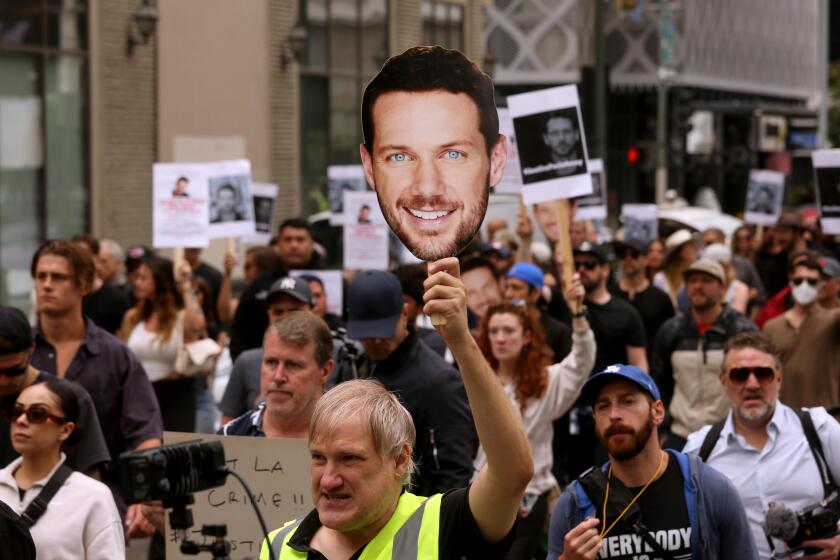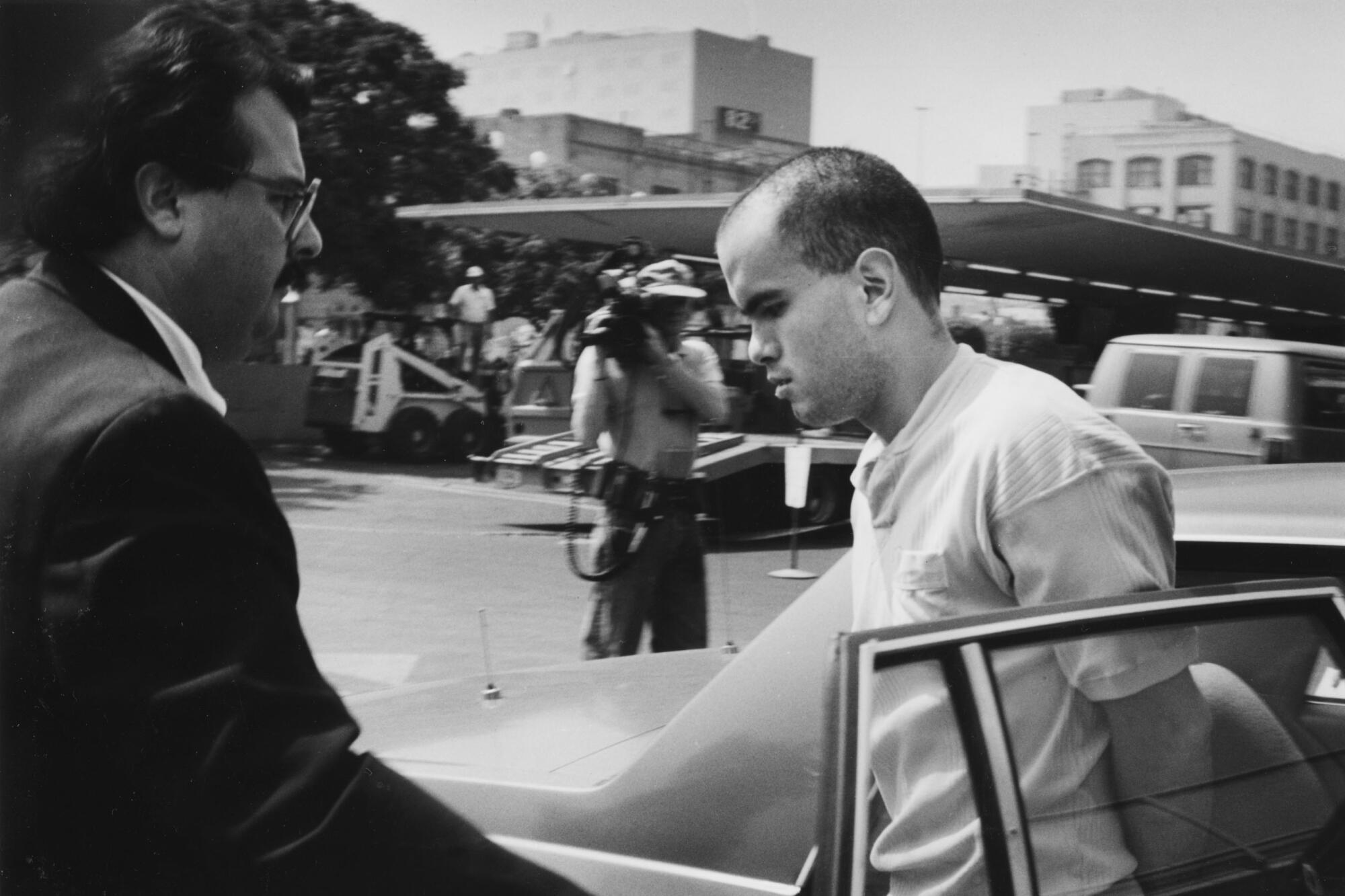
The prosecutor was studying the killer’s confession, trying to understand what was wrong with it. In her first few viewings of the videotape, Marcia Clark had the gnawing sense that he was lying. She took careful notes. She watched to the end, rewound and watched again.
On the tape, Robert Bardo was in a room at Men’s Central Jail in downtown Los Angeles, telling his defense-appointed psychiatrist how he had stalked and killed 21-year-old actress Rebecca Schaeffer. He was a misfit from Tucson, a high school dropout who had once worked the grill at Jack in the Box but couldn’t hold a job.
He had been fixated on the actress for four years. He taped every episode of “My Sister Sam,” the sitcom in which she played a bubbly, innocent teenager from 1986 to 1988. He wrote her endless letters. He quoted John Lennon lyrics. Once, she sent him a personalized response telling him that his letter was one of the nicest she’d received. Friends had warned her that even the most innocuous personal note could be misinterpreted. It seemed to inflame his fixation.
In this series, Christopher Goffard revisits old crimes in Los Angeles and beyond, from the famous to the forgotten, the consequential to the obscure, diving into archives and the memories of those who were there.
Schaffer’s father, a psychologist in Portland, Ore., would read Bardo’s letters and perceive no threat. He thought they reflected “just another strange kid who wanted someone to pay attention to him.”
Bardo had taken a Greyhound to Los Angeles, rented a cheap hotel and found his way to the Warner Bros. lot in Burbank with flowers and a teddy bear. He insisted on seeing her. A security guard drove Bardo back to his hotel and told him to go home to Tucson. Another harmless lovesick fan wanting to see a star, the guard thought; there were a couple every week.
But the 19-year-old Bardo remained fixated on Schaeffer and felt personally betrayed when she appeared in a love scene in the film “Scenes from the Class Struggle in Beverly Hills.” He had studied celebrity stalkers. He had visited the apartment building in New York where a deranged fan had murdered John Lennon. Reading a story about the man who stabbed and nearly killed actress Theresa Saldana, he realized he could hire someone to lead him to Schaeffer.
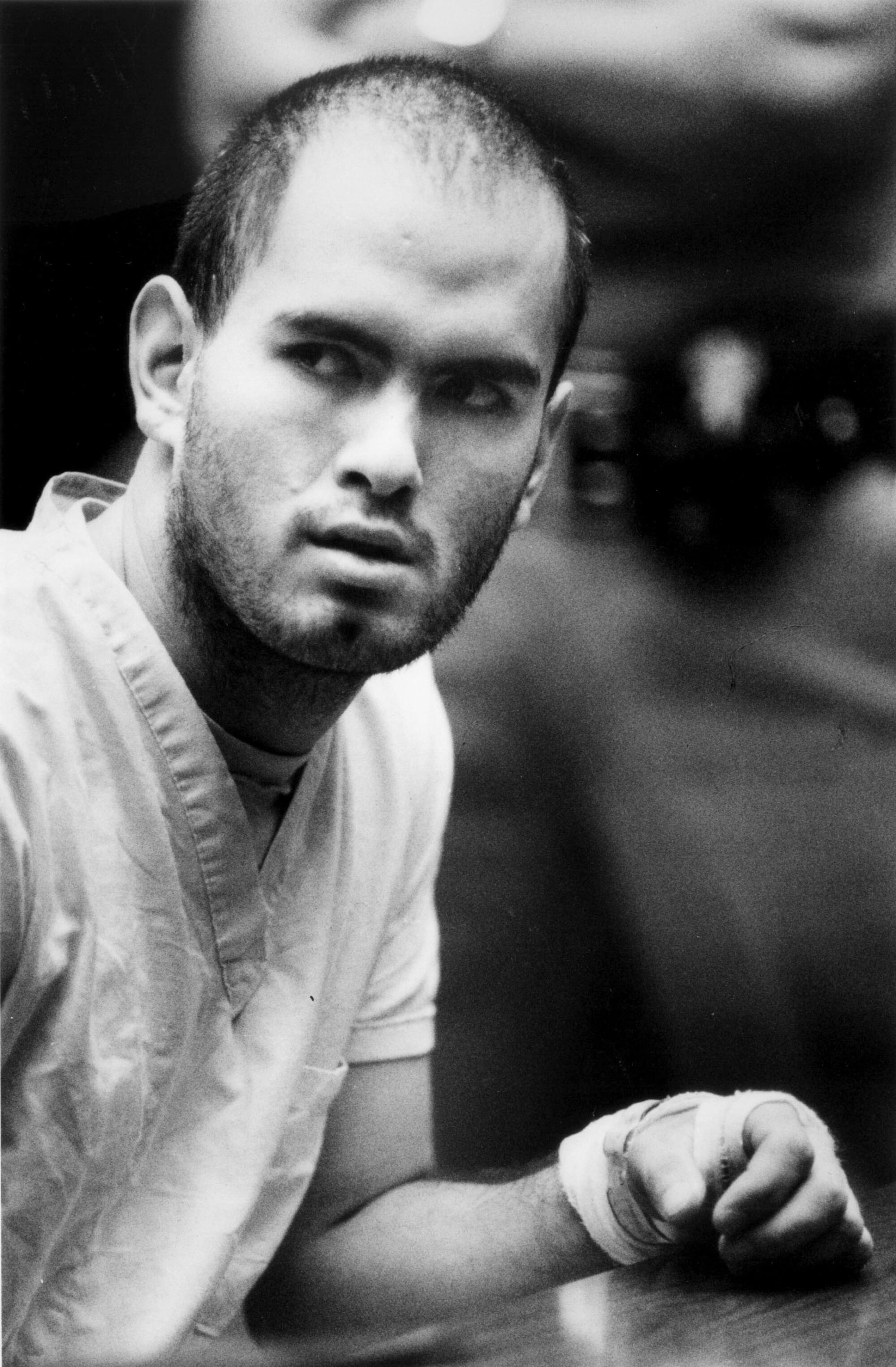
“I have an obsession with the unobtainable,” he wrote to his sister.
Schaeffer was not the only young female celebrity he developed an interest in. He had tried to find pop stars Debbie Gibson and Tiffany, as well as Samantha Smith, the girl who had written to the Soviet premier in a plea for peace.
Schaeffer was the one he was able to find, paying $250 to a private investigator, who got her home address from the DMV. He took another Greyhound to Los Angeles, this time with a .357 magnum his brother had purchased for him.
On the morning of July 18, 1989, as Schaeffer was preparing to audition for a role in “The Godfather Part III,” Bardo put a bullet through her heart when she opened the foyer door of her apartment on North Sweetzer Avenue in West Hollywood.
Rushing off in flip flops, he hurled the copy of “The Catcher in the Rye” he had been carrying onto a nearby rooftop. The next day, in Tucson, police found him running in freeway traffic, apparently trying to kill himself. He put his head on a squad car and sobbed. He said he’d shot someone.

“My feelings for her were uncontrollable,” he told an interviewer later. “I was a fan of hers, and I may have carried it too far.”
As his trial began, more than two years later, Clark had to prove he was guilty of first-degree murder, with an enhancement for lying in wait, which would send him away for life. Bardo’s public defender argued for second-degree murder, saying he had acted on impulse rather than with premeditation. If that argument prevailed, Bardo might one day walk free.
Clark thought Bardo’s videotaped jail interview might implicate him, if she could figure out what he was lying about. Under questioning from psychiatrist Park Dietz, Bardo spoke with manic intensity and an unnerving streak of braggadocio. He had come to L.A. with a “mission,” he said. He seemed amazed that Schaeffer had answered her door.
“I have an obsession with the unobtainable”
— Robert Bardo
“It’s her. … There she is. … She’s right there in front of me. … She wasn’t dressed up glamorously. … Just a regular person. … Just me and her.”
He said they chatted briefly. She smiled and told him to take care. He went away and came back. This time, he said, she seemed annoyed.
“She said, ‘You came to my door again.’ It was like I was bothering her again. ‘Hurry up, I don’t have much time.’” Bardo explained to the psychiatrist that he’d been provoked. “I thought that was a very callous thing to say to a fan.”
Bardo mimicked pulling the gun from his shopping bag and shooting her. He did it with the zeal of a man reenacting an impressive sporting feat.
“I watched it again and watched it again and again,” Clark said in a phone interview. “The defense position is it was an impulsive act, therefore second-degree murder. I thought, ‘Bulls—, there’s nothing impulsive about this guy.’ This is a planner, this is a premeditator. He came loaded for bear.”
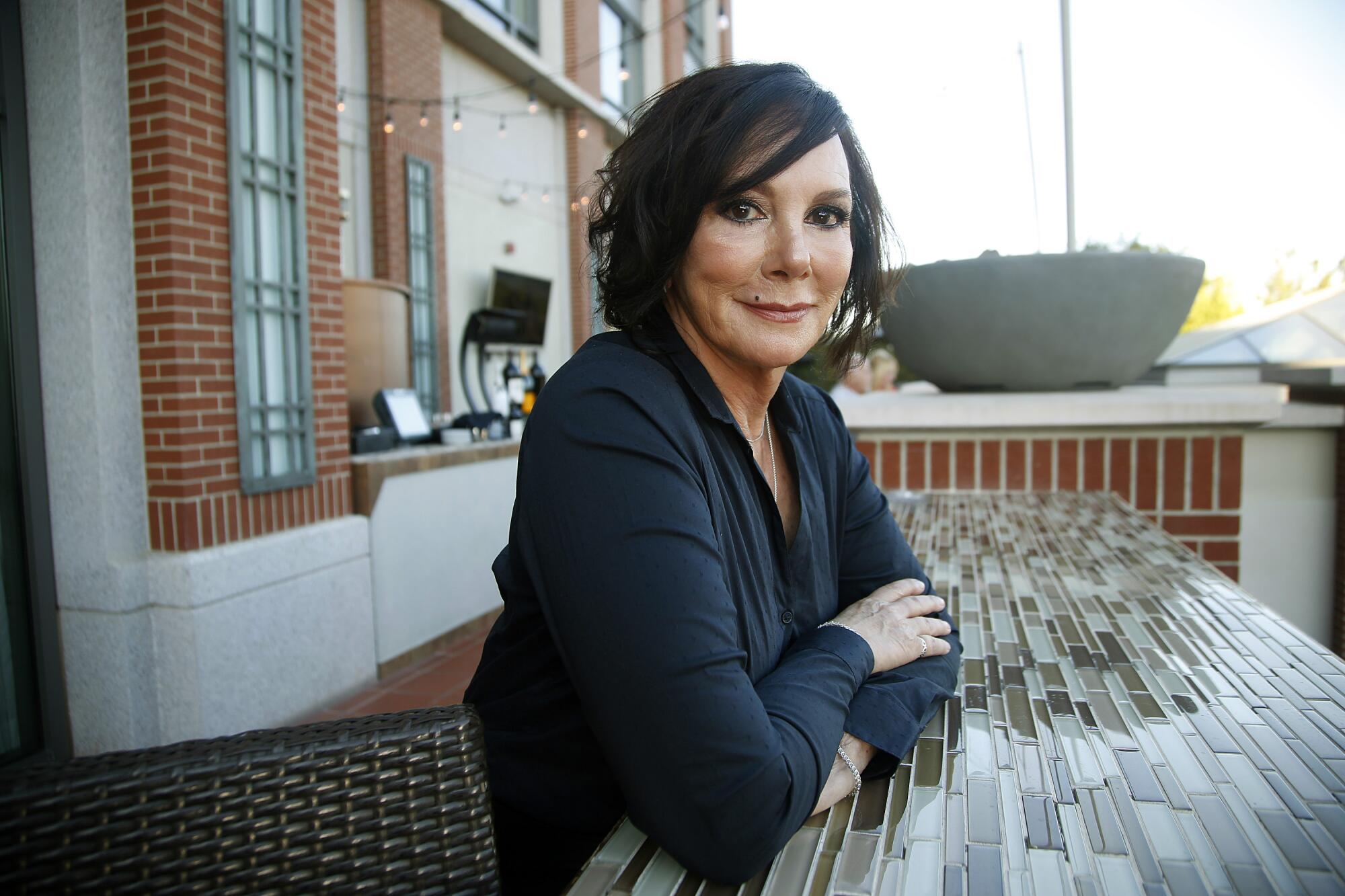
Clark hit rewind. She noticed how Bardo’s body language contradicted his words as he spoke to the psychiatrist.
“In the tape, Park Dietz asked him to re-create going back to the door. He talks about going to door and screwing up his courage. He acts it out for Park Dietz. He pulls out the handgun from behind his back, giving her no time to say anything. The theory we were pursuing was lying in wait, ambush. People think that means you have to be jumping (from) behind the bushes.
“By holding the gun behind the back where she couldn’t see it, he was lying in wait. He lured her out. I think he was holding the bag. So that when she opened the door, he had the gun behind his back. That’s what the tape showed. He was planning the murder even before she was ‘callous.’
“What struck me about the case is the naivete of everyone involved”
— Marcia Clark
“He came from Tucson with a gun. How credible is it that he was genuinely provoked in that moment?”
At the trial, Bardo’s defense attorney portrayed Bardo as a victim of mental illness and parental neglect. Dietz testified that Bardo was “a sick young man” who suffered from schizophrenia and wanted to be famous. “A movie star, writer or musician — maybe all of them,” Dietz recalled him saying.
Bardo’s high school counselor quoted letters Bardo had written in his mid-teens. “The people at school did a good job of stopping me from killing myself. They made a mistake because they saved the devil. Now the devil must kill. I’m going to be the next Hitler.”
Clark argued that Bardo killed Schaeffer for fame and that he had not been under the influence of any command delusions, such as voices ordering him to kill, when he gunned the actress down. Judge Dino Fulgoni agreed that Bardo, who waived a jury trial, had lain in wait, saying he may have had schizophrenia but his condition did not preclude premeditation.
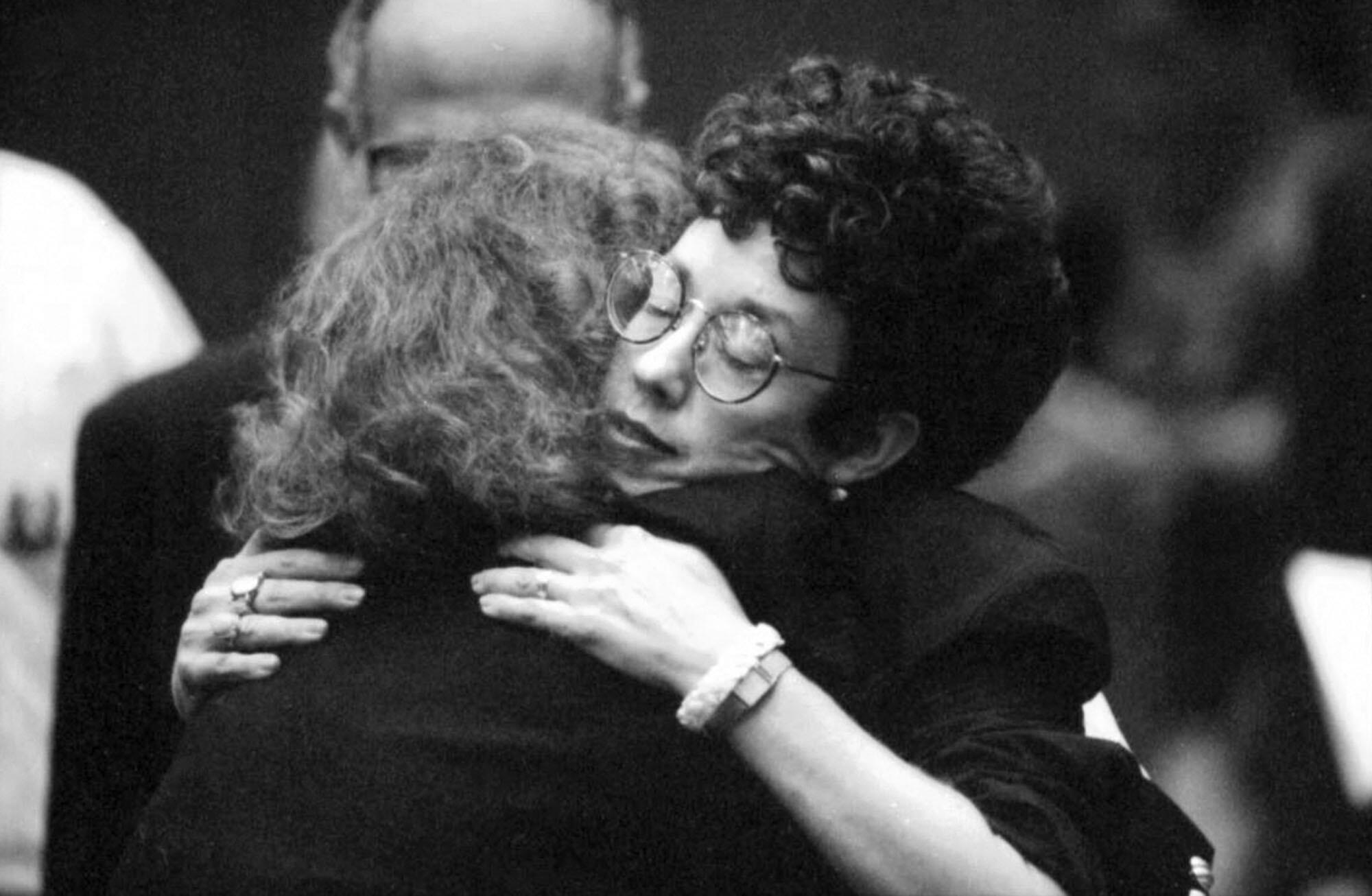
The judge gave him life without the possibility of parole. In 2007 at Mule Creek state prison, another inmate stabbed him 11 times with an improvised blade. He survived.
Clark, who now represents indigent clients on criminal appeals, looks back on the Schaeffer case and thinks about how dimly people, herself included, grasped the stalking phenomenon in 1989.
“What struck me about the case is the naivete of everyone involved,” Clark said. “When Bardo surfaced at the studio, the guard thought, ‘It’s a lovesick fan’ and thought nothing more of it. So she never knew this guy was actually tracking her. My memory of it is no one assigned a great deal of significance to this guy, and that’s understandable at the time. Probably 100 guys like that showed up and never appeared again and never caused a problem.”
She consulted with Gavin de Becker, who studied stalkers. He explained the nature of their obsessions and motivations. She began to understand what animated the killer.
“He doesn’t love her. He doesn’t know her. She’s pixels on a TV screen, that’s all. Gavin said, ‘This is very common. They start with this love and attach to this person they don’t know and then find a reason to turn on them.’”

If you have information on old crimes, famous, once-famous or obscure, contact [email protected]
In reforming the legal landscape, Clark’s first major case had a far greater impact than the one she would lose, a few years later, against O.J. Simpson’s “dream team.”
With stunning swiftness, Schaeffer’s killing inspired California legislators to pass the nation’s first laws making stalking a crime, which unleashed similar laws across the country and the world. The case also inspired the LAPD to launch a threat assessment unit and fueled the rapid growth of the now-enormous private threat assessment industry.
Lawmakers also limited the information the DMV could legally release, a measure whose usefulness has since withered. What Bardo learned from a private eye, stalkers can now find with a click.
Still, the stalking laws are widely used. “Thank goodness these laws were put in place before the explosion of the internet,” Clark said. “Even more than the laws, public awareness matters.”
From his cell at Avenal State Prison, Bardo, now 54, is attempting to refashion himself as a helpful expert in the psychological derangements he came to embody. In January, he wrote to Joseph Dalu, a Laguna Hills private investigator and threat assessment expert he saw on a TMZ special about Hollywood stalkers called “Obsessed & Dangerous.”
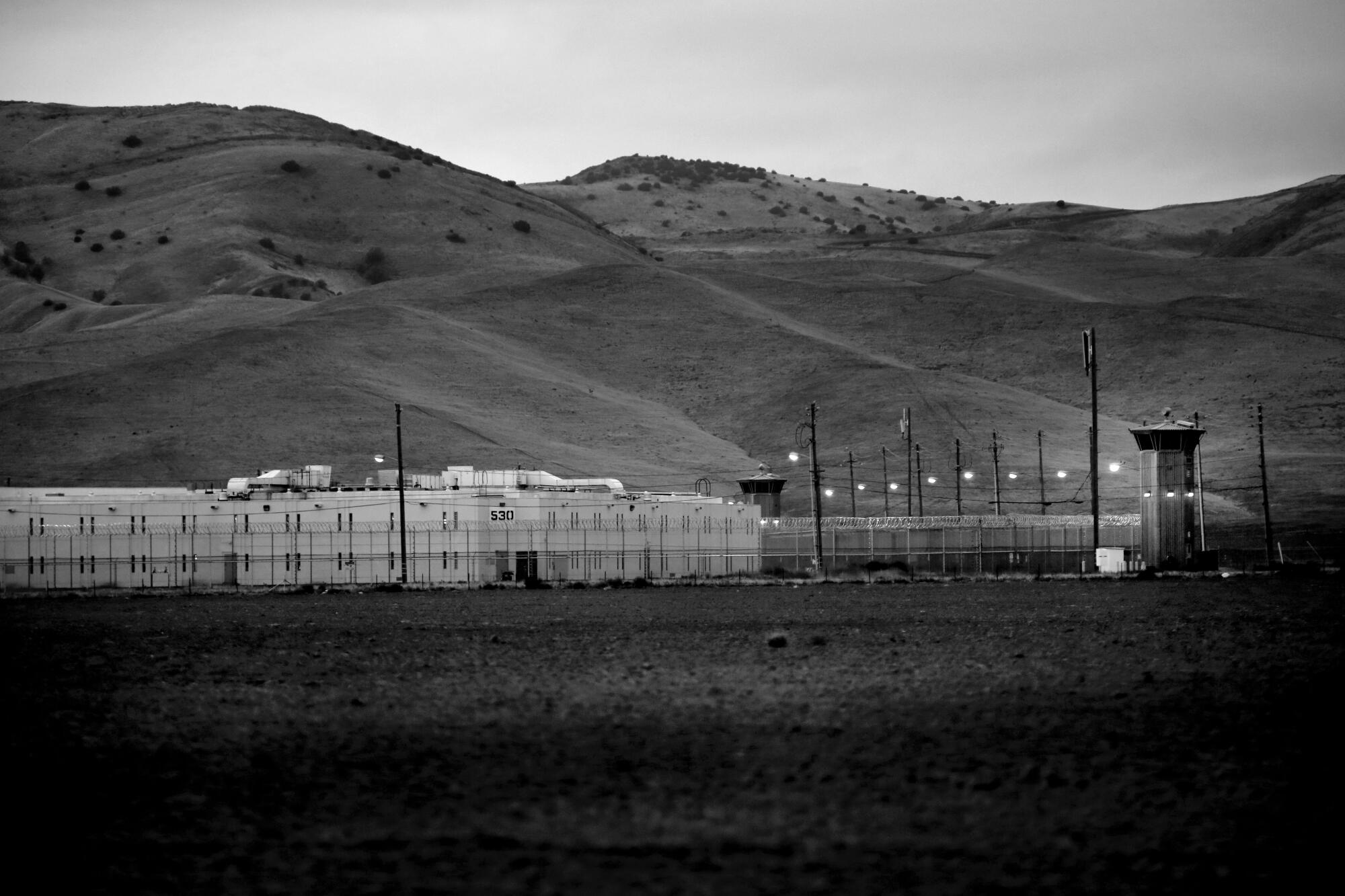
“I am in prison for an infamous notorious case involving Hollywood,” Bardo wrote. “I wish to, with your permission/consent, to correspond with you on this issue of stalking behavior to offer my insights the best I can.”
The letter mingled braggadocio, grievance and therapeutic platitudes.
“I had tried contacting the LAPD threat management unit and they did not respond even though I am the reason they exist,” he continued. “A stalking case is like an asteroid on its way to Earth. Your efforts are like the little gravity nudge that safely changes its trajectory way before impact. … Many stalkers latch on to their delusions the way Linus clings to his comfort/security blanket in the Peanuts comics. It is the maladaptive coping skill to their lives. It is frightening.”
Dalu said it’s possible that Bardo does have a sincere interest in shedding light on the mentality of stalkers. It would be impossible to know unless he talks to Bardo. He has considered it carefully. He plans to.
“It would definitely be interesting to see where his mind is now,” Dalu said. “If those are true intentions, then I would be interested, but I don’t want to make it to where he becomes a celebrity again.”
More to Read
Sign up for Essential California
The most important California stories and recommendations in your inbox every morning.
You may occasionally receive promotional content from the Los Angeles Times.












